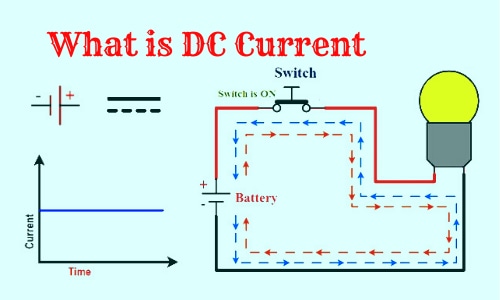What is DC Current or Direct Current
Hello friends! Welcome back to ElectroDuino. This blog is based on DC Current or Direct Current. Here we will discuss what is DC Current or Direct Current, Symbol, Characteristic Graph, Sources Current flow in a circuit, how to measure current, Properties and Use.
What is Direct Current or DC Current?
Direct Current is one type of electric current that flows in only one direction, it does not change direction. It does not change direction and flows in only one direction, due to this gives its name DC or Direct current. Electric current flows in a conductor due to the movement of electric charge. So, in other words, we can say that when the electric charge flows in one direction inside the conductor, then this type of current is called DC or Direct Current.
DC Current Symbol
The DC current always flows in one direction (Forward or backward). Therefore, the Straight line is used as a symbol of the DC current. The below figure shows the symbol of DC current and AC current, which shows differences between them.
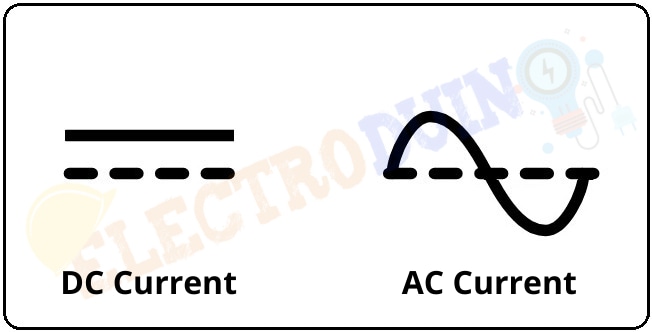
Characteristics Graph of direct current
The main characteristic of direct current is it only flows in a single direction. But it can be seen to be either positive or negative only. The voltage and current of a DC source can vary (High or Low) over time, but the direction of flow does not change. When we connect a DC voltage source to an oscilloscope, it will show a straight line.
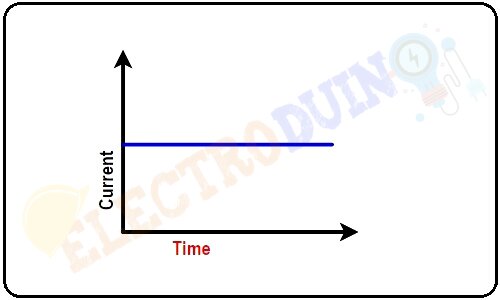
Sources of direct current
Some examples of DC current sources:
- Solar Cells
- Batteries
- fuel cells
- A generator can produce Direct current by connecting a Commutator.
- Also, we can convert Alternating current (AC) to DC using rectifier circuits, like Half Wave Rectifier, Full Wave Rectifier, and Full Wave Bridge Rectifier.
Symbol of DC Voltage Source
All DC voltage source has two fixed terminals (polarity) positive or anode (+) and Negative or cathode (-). Therefore, when we design or draw a DC circuit diagram, we must use a Specific symbol of the DC voltage source which can show the polarity of the source. There are two types of symbols, the figure is shown below

The longer vertical line or Plus sign (+) represents the Positive or Anode terminal of the DC voltage source, and the shorter vertical line or minus sign (-) represents the Negative or Cathode terminal.
Direction of DC Current flow (Electron and Current Flow)
We know that the current is flow due to the flow of charge or electrons. The direction of the flow of current depends on the direction of the flow of charge or electrons. Always the current flows in the opposite direction of the flow of charge or electrons.
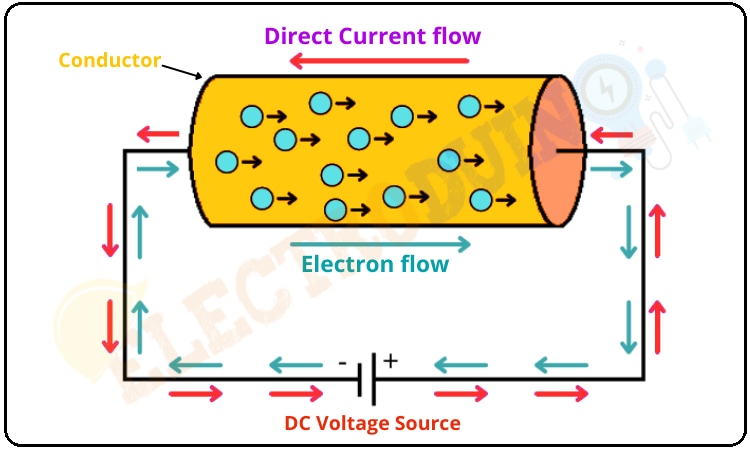
The electrons (charge) always flow from the negative or cathode (-) terminal of the battery to the positive or anode (+) terminal of the battery. So, the current flows from the positive or anode (+) terminal of the battery to the negative or cathode (-) terminal of the battery. In other words, we can say that current flows from the higher potential region as positive to the lower potential region as negative.
How Direct Current or DC Circuit Works (Direction of Electron and Current in DC Circuit)
The minimum components required to construct a DC circuit are battery, on/off switch, and a Load (bulb). The figure is shown below
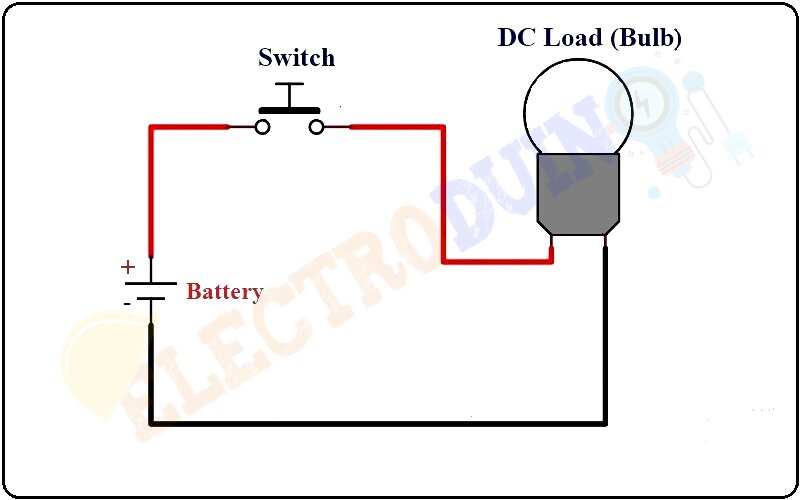
Let us assume that initially, the switch is turned off condition. This means that there is no continuous path (path is open) for current (electrons) to flow in this circuit. So, in this condition, no current (electrons) flows through this open path and the circuit act as an open circuit. As a result, the bulb is in turn off state.
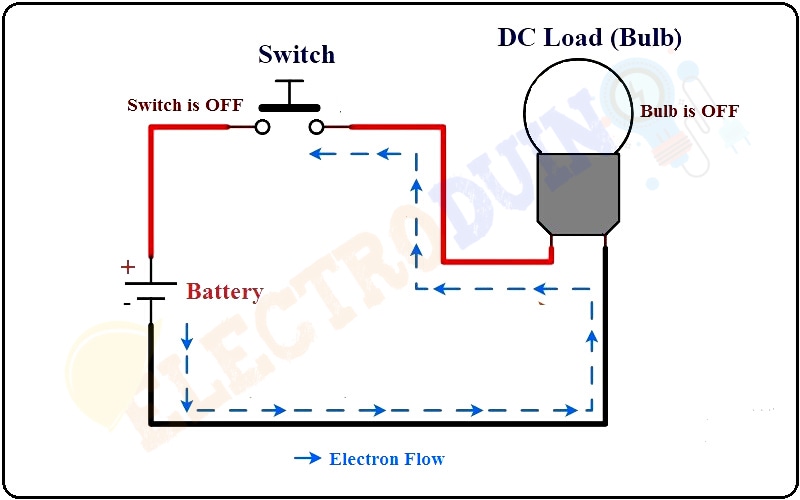
When we turn on the switch, then the circuit has no open path (the path is continuous). So, the circuit act as a closed circuit. In this condition, the electrons or charge starts to flow from the negative terminal of the battery to the positive terminal of the battery through the bulb (load). So, the current starts flowing from the Positive terminal of the battery to the Negative terminal through the bulb (load). As a result, the bulb gets some energy and it starts glowing.
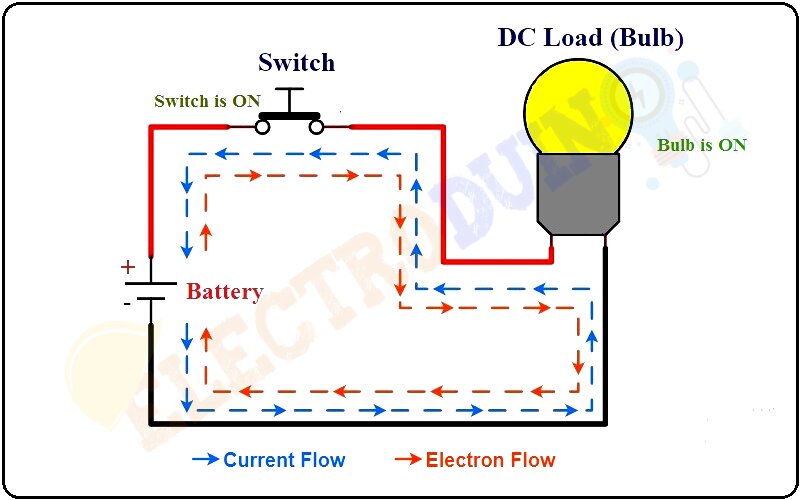
How to measure Direct current and Voltage
The Direct current and Voltage can be measured by a multimeter. To measure the current flow through the load, the multimeter is always connected in series with the load.
For example, we take a DC circuit, which consists of a LED, Resistor, and Direct Current voltage Source (Battery). Now we need to measure the current flow through the circuit. So, we will connect a multimeter in series to the circuit. The Com probe (Black probe) of a multimeter is connected with the negative terminal of the Voltage Source and the positive probe (red probe) is connected to the LED (DC load). Now the multimeter shows the value of current flow through the circuit. In this way, we can measure the DC current flow through a circuit or load.
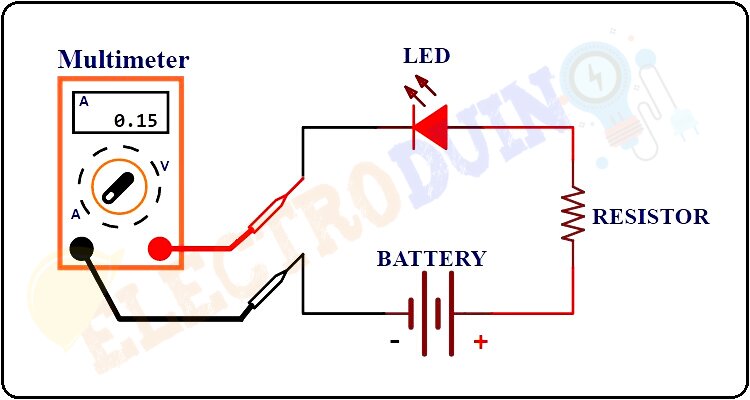
Properties
- It only flows in one direction in the circuit or conductor.
- The frequency of direct current will be zero.
- It is the current of constant magnitude.
- It can be of Pure and pulsating
- Its Power Factor will be always 1.
- Direct Current source has fixed polarity Positive (+) and Negative (-) signs.
- Its impedance is purely resistive.
- It can be directly stored (like a battery).
Uses of DC or Direct current
In this modern-day we all are using many household electronic devices that are operated by a DC voltage source, the most popular of them is Phones. Also use in the TV remote, AC remote, calculator, Digital Watch, clock, car batteries, laptops, emergency lights, etc. are operated by the direct current source like a battery.

